Kelvin-Helmholtz Waves and Crepuscular Rays - OPOD
Kelvin-Helmholtz Waves and Crepuscular Rays - Exploring Atmospheric Phenomena
Atmospheric optics is a captivating field that unveils a multitude of intriguing natural phenomena. Among these phenomena are the Kelvin-Helmholtz waves and crepuscular rays, which have the ability to mesmerize and astonish observers. In this article, we will delve into the fascinating world of these atmospheric marvels, shedding light on their formation, characteristics, and significance.
Kelvin-Helmholtz instability waves manifest when two fluids, such as air masses, move at different velocities, creating shear at their interface. As a result, small disturbances within the fluid layers are amplified, giving rise to regularly spaced rotating structures. These wave clouds, often observed in the sky, cast captivating shadows across their surroundings, captivating the attention of keen observers.
In the case of Kelvin-Helmholtz waves observed in the atmosphere, the layers involved consist of air with different temperature and density. The presence of these atmospheric K-H waves serves as an indication of significant air turbulence. The intricate interplay between fluid dynamics and atmospheric conditions results in the formation of these awe-inspiring patterns.
The mesmerizing beauty of Kelvin-Helmholtz waves is not limited to our planet alone. Even in the vast expanse of space, these waves leave their mark. For instance, Jupiter's iconic red spot, measuring approximately 2-3 times the diameter of Earth, is a testament to the influence of Kelvin-Helmholtz instability. This colossal storm system, captured by Voyager 2, showcases several atmospheric streams with varying velocities. At the boundaries between these streams, Kelvin-Helmholtz waves emerge, contributing to the dynamic nature of Jupiter's atmosphere.
Crepuscular rays, also known as "sunbeams," are another atmospheric optical phenomenon that captivates observers worldwide. These radiant beams of sunlight appear to radiate from the position of the sun, piercing through gaps in clouds or other obstructions in the atmosphere. The term "crepuscular" refers to the twilight period when these rays are often most visible, adding a touch of mystique to their allure.
The formation of crepuscular rays is attributed to the scattering of sunlight by atmospheric particles such as dust, water droplets, or ice crystals. When sunlight encounters these particles, it scatters in various directions, resulting in the distinctive appearance of rays extending across the sky. The interplay between light and atmospheric constituents creates a visual spectacle that evokes a sense of wonder and awe.
As the sun sets or rises, the angle at which sunlight enters the atmosphere changes, influencing the direction and intensity of crepuscular rays. This dynamic interplay between light and atmospheric conditions contributes to the ever-changing nature of these ethereal beams. Observing crepuscular rays offers a glimpse into the intricate dance between light and matter within our atmosphere.
To capture the beauty of Kelvin-Helmholtz waves and crepuscular rays, photographers and enthusiasts often find themselves captivated by these atmospheric phenomena. The interplay of light, shadows, and dynamic patterns provides ample opportunities for artistic expression and appreciation of nature's grandeur. Photographs capturing these fleeting moments serve as a testament to the ephemeral beauty that exists within our atmosphere.
In conclusion, the world of atmospheric optics continues to unveil captivating phenomena such as Kelvin-Helmholtz waves and crepuscular rays. These awe-inspiring spectacles remind us of the intricate dynamics at play within our atmosphere and the remarkable beauty that surrounds us. Whether witnessing the mesmerizing rotation of Kelvin-Helmholtz wave clouds or being bathed in the ethereal glow of crepuscular rays, these natural wonders leave an indelible mark on our collective consciousness. Let us continue to explore and appreciate the enigmatic realm of atmospheric optics, for it holds endless marvels waiting to be discovered.
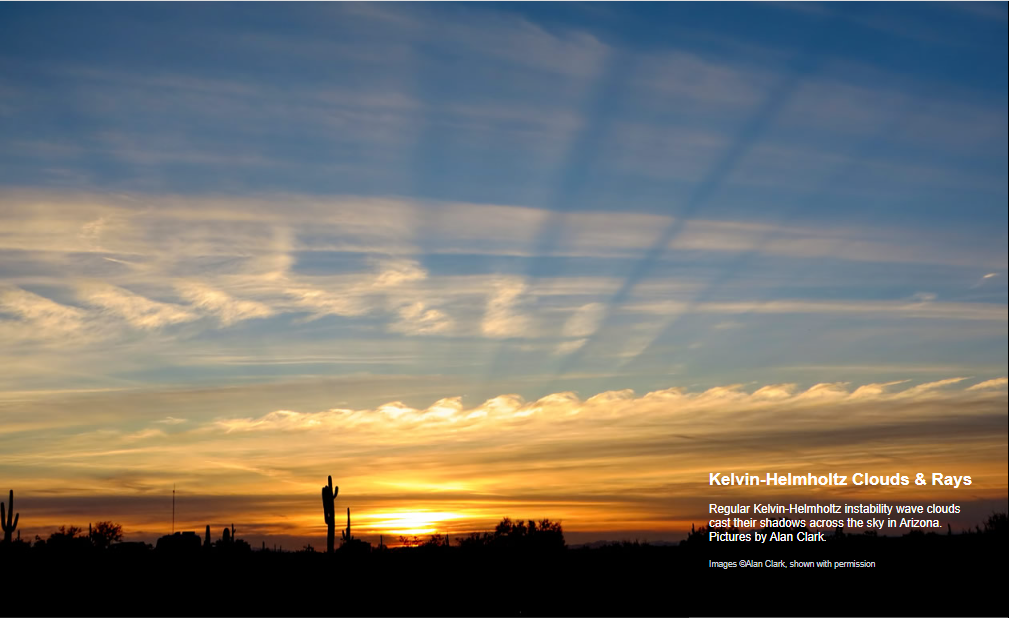
Kelvin-Helmholtz Clouds & Rays
Regular Kelvin-Helmholtz instability wave clouds cast their shadows across the sky in Arizona. Pictures by Alan Clark.
Images ©Alan Clark, shown with permission
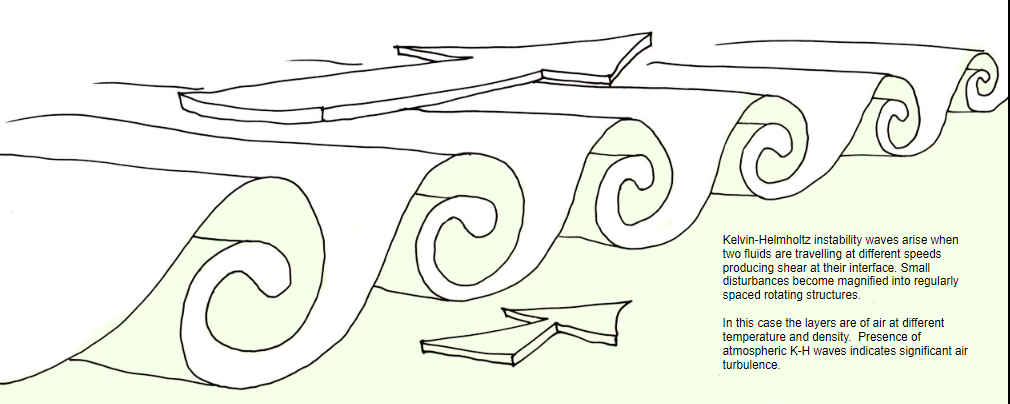
Kelvin-Helmholtz instability waves arise when two fluids are travelling at different speeds producing shear at their interface. Small disturbances become magnified into regularly spaced rotating structures.
In this case the layers are of air at different temperature and density. Presence of atmospheric K-H waves indicates significant air turbulence.
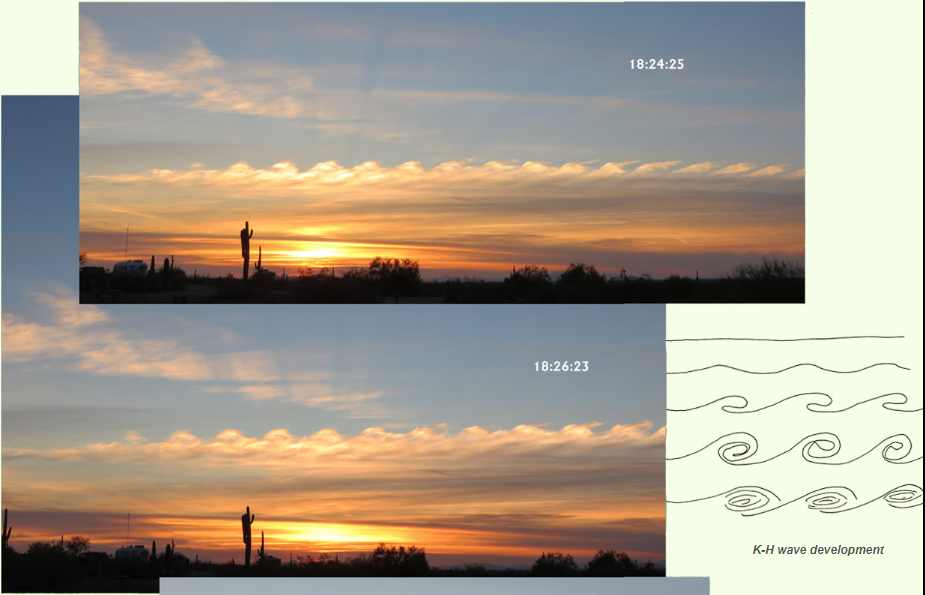
Changes in the waves over several minutes recorded by Alan Clark.
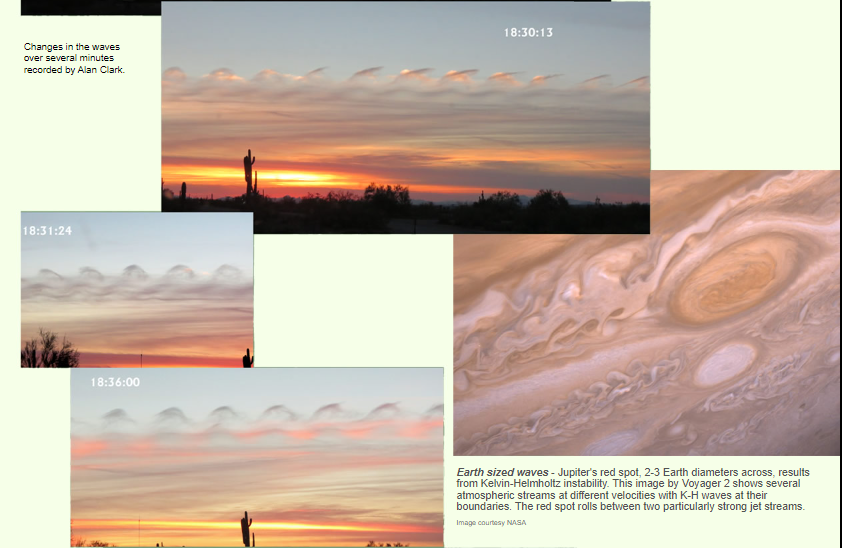
Earth sized waves - Jupiter's red spot, 2-3 Earth diameters across, results from Kelvin-Helmholtz instability. This image by Voyager 2 shows several atmospheric streams at different velocities with K-H waves at their boundaries. The red spot rolls between two particularly strong jet streams.
Image courtesy NASA
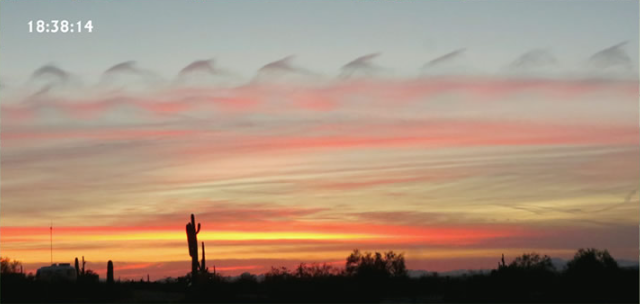
Note: this article has been automatically converted from the old site and may not appear as intended. You can find the original article here.
Reference Atmospheric Optics
If you use any of the definitions, information, or data presented on Atmospheric Optics, please copy the link or reference below to properly credit us as the reference source. Thank you!
-
<a href="https://atoptics.co.uk/blog/kelvin-helmholtz-waves-and-crepuscular-rays-opod/">Kelvin-Helmholtz Waves and Crepuscular Rays - OPOD</a>
-
"Kelvin-Helmholtz Waves and Crepuscular Rays - OPOD". Atmospheric Optics. Accessed on April 16, 2024. https://atoptics.co.uk/blog/kelvin-helmholtz-waves-and-crepuscular-rays-opod/.
-
"Kelvin-Helmholtz Waves and Crepuscular Rays - OPOD". Atmospheric Optics, https://atoptics.co.uk/blog/kelvin-helmholtz-waves-and-crepuscular-rays-opod/. Accessed 16 April, 2024
-
Kelvin-Helmholtz Waves and Crepuscular Rays - OPOD. Atmospheric Optics. Retrieved from https://atoptics.co.uk/blog/kelvin-helmholtz-waves-and-crepuscular-rays-opod/.